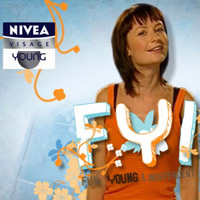Lots of factors affect the end price of a product, for example, the costs of production or the
business need to
maximise profits or sales. A product’s price also needs to provide
value for
money in the market and
attract consumers to buy.
There are several
pricing strategies that a business can use:
•
Cost based pricing – this can either simply cover costs or include an
element of profit. It
focuses on the product and does not
take account of
consumers.
•
Penetration price – an initial low price to ensure that there is a high volume
of
purchases and market
share is quickly won. This strategy
encourages
consumers to develop a
habit of buying.
•
Price skimming – an
initial high price for a unique product encouraging
those who want to
be ‘first to buy’ to pay a
premium price. This strategy
helps a business to
gain maximum
revenue before a competitor’s product
reaches the market.


On
re-launch the price for NIVEA VISAGE Young was
slightly higher than previously. This
reflected its new
formulations, packaging and
extended product range. However, the
company also had to
take into account that the target market was both teenage girls and
mums buying the product for their daughters. This meant that the price had to offer
value for
money or it would be out of reach of its target market.
Price leader
As NIVEA VISAGE Young is one of the leading skin care ranges meeting the beautifying needs
of this market segment, it is
effectively the price leader. This means that it sets the price
level that competitors will follow or
undercut. NIVEA needs to regularly
review prices should
a competitor enter the market at the ‘market growth’ point of the product life
cycle to
ensure that its pricing remains competitive.
Product life cycle:
the stages
through which a product passes
from its initial launch to final
withdrawal.
The pricing strategy for NIVEA is not the same as that of the retailers. It sells products to
retailers at one price. However, retailers have the freedom to use other strategies for
sales
promotion. These take account of the competitive nature of
the high street. They may use:
•
loss leader: the retailer sells for less than it cost to attract large volume
of sales, for example by supermarkets
•
discounting –
alongside other special offers, such as ‘Buy one, get one
free’ (BOGOF) or ‘two for one’.
NIVEA VISAGE Young’s pricing strategy now
generates around 7% of NIVEA VISAGE sales.




